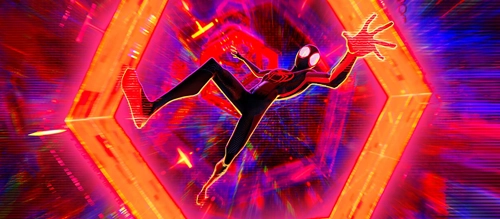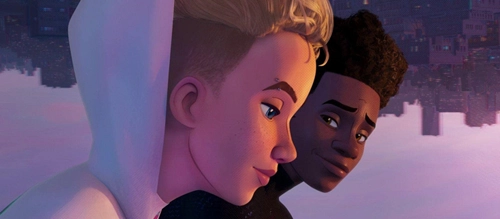Spider-Man: Across the Spider-Verse (2023) Review

Spider-Man: Across the Spider-Verse (2023)
Directors: Joaquim Dos Santos, Kemp Powers, Justin K. Thompson
Screenwriters: Phil Lord, Christopher Miller, Dave Callaham
Starring: Shameik Moore, Hailee Steinfeld, Oscar Isaac, Jake Johnson, Issa Rae, Bryan Tyree Henry, Luna Lauren Velez
After four long years, the sequel to the “electric, atmospheric festival of colour” that was Sony Pictures Animation’s Oscar-winning, genre-defining, form-shaping Spider-Man: Into the Spider-Verse has arrived. The film that fought against a tried and tested formula, that rewrote the lore of a studio staple, that was so fresh and interesting it was almost as if it should have never existed, was such a critical success that perennial safety shooters Sony were willing to experiment once again. This time, Miles Morales and company, under the stewardship of original co-writers and producers Phil Lord and Christopher Miller, are rewriting even more of the rule book.
Shameik Moore’s cool and relatable hero is introduced to a wider spider-verse by Hailee Steinfeld’s returning Gwen Stacy, who takes on a more central and well-rounded role in this highly-anticipated sequel. The heroine uses portal devices to cross between a multi-verse of spider-people as she and Miles experience grave family struggles. The concept of the multiverse may have been overplayed in recent years, but so rarely has it seemed this original, dynamic and brimming with life, and only in Into the Spider-Verse have the personal stakes been this high.
There are spider-people and spider-creatures galore, the cameos and more influential inclusions each being illuminated by an array of animation styles, a cornucopia of unique audio-visual elements. There are eye-widening design choices and smile-inducing casting choices, and every promise Sony’s marketing department offered in Across the Spider-Verse’s trailer is spectacularly realised.
Across the Spider-Verse is the longest animated feature in history at 2 hours and 20 minutes, but it leaves barely a moment to blink, the rapid and ever-original action slowing only to propel moments of inner conflict, interpersonal dynamics or existentialism to the forefront. Every central character is well taken care of, the beating heart that made the original so comforting and charismatic still intact – every development in Across the Spider-Verse feels at one with the film that came before. This is more than a good sequel that ramps up all that we enjoyed about the original, it is a reach into an unknown pool of perfection, a ginormous studio-backed swing at something special.
This version of Spider-Man has undergone one of the more trying coming-of-age tales of the feature film spider-people we’ve seen across various live-action franchises to date, and the connection this has forged between us and him ensures that each of his potentially multiverse-altering choices is felt from the off. Lord and Miller, who worked on the original Spider-Verse and fellow Sony Pictures Animation film Cloudy with a Chance of Meatballs, have always given a lot of room for character choices in their texts. And, in a world of so many moving parts – characters, narratives, themes, animation styles – it is testament to their commitment to character choice that Across the Spider-Verse manages to capture the same connection as the original.

There is a short period in the middle of the film where the narrative sags a little, and certainly more could have been done to develop one of the film’s two central villains and the extent of their powers in the first half of the film – where we are left guessing as to just how much of a threat this character could be and what this might mean for Miles and Gwen – but these pitfalls are barely noticeable among the pantheon of extraordinary efforts made to excite and ignite our imaginations. In these moments, comedy, cameos, references and soundtrack take the lead, each expressively exploding out of the animation.
As an animated film, there are few contemporaries. Not since Toy Story rewrote animated feature history in the mid-90s had mainstream western animation been evolved and shunted forward with such force as in Into the Spider-Verse, and Across the Spider-Verse is somehow even more eccentric. Whether it be minutes of black and white sequences, pen lines and all, or watercolour constructions that change colour to match the conflict apparent in the dialogue, Across the Spider-Verse is an Oscar-winning short film’s unique and ultra-expressionistic sensibility attached to a mainstream intellectual property and presented by over 1,000 of the world’s best animators. It’s wondrous stuff, the kind of style that is worthy of the film’s dream-factory concept.
Spider-Man: Across the Spider-Verse is why people go to the cinema. It is why you should go to the cinema. It is a phenomenon of style and substance that begs to be seen on the big screen. Lord and Miller, and their partners at Sony Pictures Animation, have once again captured lightning in a bottle. Across the Spider-Verse is ultra modern storytelling that captures the personality, fears and ambitions of our current era – it is eye-popping spectacle and hearty, moving passion side-by-side. As a sequel, we must consider this among the pantheon of greats that Spider-Man 2 (2004) belongs to, and as an animated film this is a certified all-timer. There’s no doubt that you’ll be left wanting more, but as things are… Spider-Man doesn’t get better than this.
Score: 22/24
Recommended for you: Spider-Man Movies Ranked

